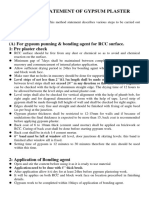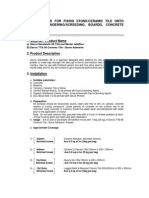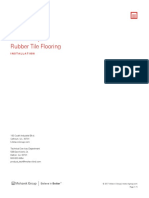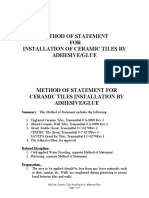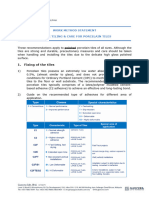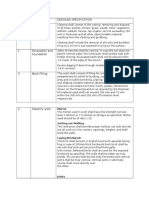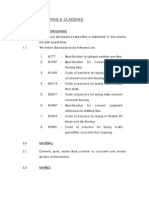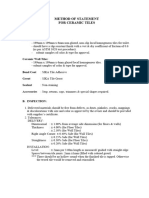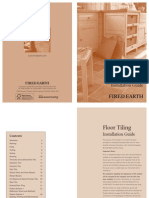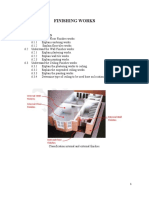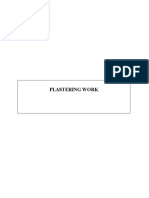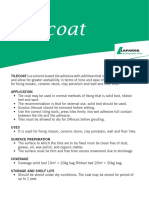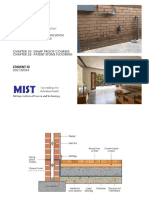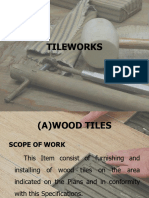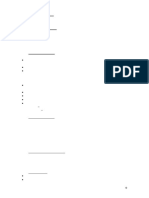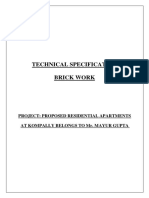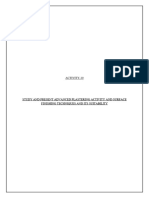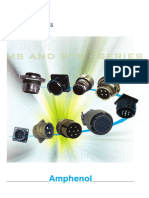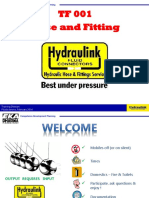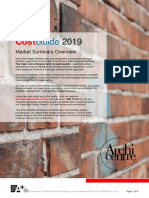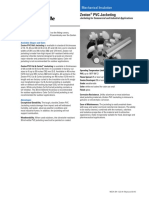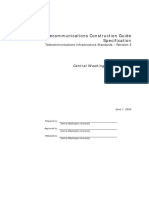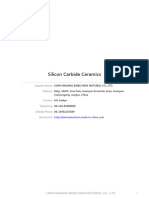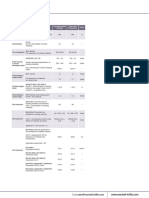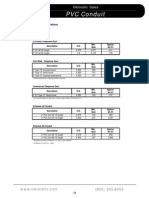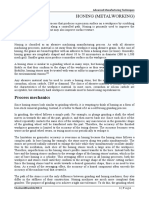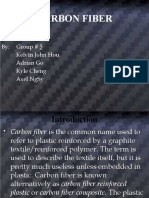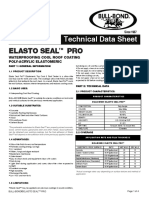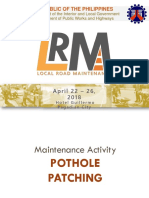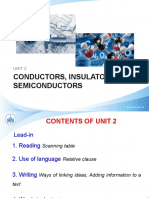MS Ta 361 Taw 36
MS Ta 361 Taw 36
Uploaded by
rainman27Copyright:
Available Formats
MS Ta 361 Taw 36
MS Ta 361 Taw 36
Uploaded by
rainman27Original Description:
Original Title
Copyright
Available Formats
Share this document
Did you find this document useful?
Is this content inappropriate?
Copyright:
Available Formats
MS Ta 361 Taw 36
MS Ta 361 Taw 36
Uploaded by
rainman27Copyright:
Available Formats
METHOD STATEMENT
QuickMix TM Adhesive
Tile Adhesive 361/ Tile Adhesive White 363
1. Description
QuickMix TM Tile Adhesive is a premium polymer modified cement based adhesive for
tile fixing. It is formulated for higher performance to meet higher requirements tile
fixing. It is suitable for both internal and external applications over concrete, brickwork
and rendered surfaces. Tile adhesive is ideal for installing ceramic and homogeneous tiles
for walls and floors. Because of its water-resistant property, it can be used in toilets,
kitchen and wet areas. However, Tile Adhesive is not suitable for immersed or swimming
pool application. Tile adhesive should not be used on painted surfaces.
2. Substrate Preparation
Before carrying out tile-fixing works ensure that:
a) All surfaces must be structurally sound, clean, free from dust, oil and any
traces of foreign materials that may affect adhesion of the tile adhesive on the
substrate.
b) Brick, block and concrete walls/ floors must be allowed to cure for a
minimum of 4 weeks prior to tiling.
c) Cement render and screed must be allowed to cure for at least 7 days and
finished to semi-smooth finish with a wood float. After curing, a thorough
check on the soundness in adhesion of the screed and render should be carried
out. All substrate defects should be properly rectified.
d) Painted surface must be scrapped to expose the original substrate for direct tile
fixing. .
e) The trueness of the background surface required for adhesive beds should be
such that, when check with a 2m straightedge, any gap under the straightedge
between points of contact does not exceed 3mm. When the gap exceeds 3mm,
local correction of the background by dubbing out up to 6mm thick using the
same adhesive can be done.
f) Thoroughly dampen the substrate with water and allow access to drain away.
3. Application of QuickMixTM Tile Adhesive
a) Mix one bag (25kg) of Tile Adhesive with approximately 6 litres of clean
water.
b) Mix thoroughly with an electrical mixer for 3-5 minutes until the desire
homogeneous mortar paste is achieved. Allow the mixture to stand for 3-5
minutes, remix, and then use the mixture.
4. Application
a) Tile Adhesive is applied to the prepared surface with a trowel and then
combed through with a suitable sized notched trowel onto the surface. As a
general guide, use 6mm x 6mm notched trowel for tiles size 300mm x 300mm
and below; and 10mm x 10mm notched trowel for tiles 300mm x 600mm.
b) Do not spot fix or soak the tiles. Clean back of the tile with a damp cloth if it
is dusty.
c) Only spread enough adhesive so that the tile can be fixed within the open
time. Care should be taken to spread adhesive that can be completed before
the surface of adhesive begins to form a skin. After spreading the adhesive,
press the tile firmly into the tile faces with a damp sponge before the adhesive
sets.
d) As fixing proceeds, a tile should be removed occasionally to check that the
maximum possible contact is being maintained with the adhesive.
e) As a general guideline, tile size 300mm x 600mm, with high ribs or lugs,
grooves or uneven back must be buttered flat or covered with 1~2mm of
adhesive before placing the tiles on the comb adhesive bed on the substrate so
that the voids are filled.
5. Protection
a) Tiles installed with Tile Adhesive must not be subject with running water or
rain for at least 24 hours.
b) Grouting can be carried out 24 hours after completion of tiling.
c) Light pedestrian traffic is allowed 4 days after completion of tiling and
grouting.
d) Heavy pedestrian traffic is only permitted 14 days after completion.
e) Impact vibration and hammering on adjacent and / or backside of walls are
prohibited for as long as proper curing of materials requires.
f) At all times, the floor and wall tiles should be kept clean and free from all
materials likely to cause stains, e.g. oils, grease and paint.
g) Appropriate types of sheets, boards should be laid loosely over the floor for
protection.
h) Access to the completed works should be restricted during the curing period.
You might also like
- Method Statement - Vinyl FlooringDocument3 pagesMethod Statement - Vinyl FlooringYeo Jui Yang Adrian67% (3)
- Method Statement For Stamped ConcreteDocument4 pagesMethod Statement For Stamped ConcreteAndré van Schalkwyk100% (2)
- Estimation and Quantity Surveying 1Document10 pagesEstimation and Quantity Surveying 1RajanRanjanNo ratings yet
- Gypsum Plaster Method StatementDocument2 pagesGypsum Plaster Method Statementnareshgh88_60327018250% (6)
- Metal Furring System PDFDocument4 pagesMetal Furring System PDFJane Christy PensergaNo ratings yet
- Davco Super TTB 998 + Davelastic 98 PDFDocument3 pagesDavco Super TTB 998 + Davelastic 98 PDFNanie RidzwanNo ratings yet
- Davcoflex 666 PDFDocument3 pagesDavcoflex 666 PDFNanie RidzwanNo ratings yet
- Davelastic 98 + TTB 98 PDFDocument3 pagesDavelastic 98 + TTB 98 PDFNanie RidzwanNo ratings yet
- Unit 5, BMC (Civil Polytechnic) K Scheme 2024-25Document6 pagesUnit 5, BMC (Civil Polytechnic) K Scheme 2024-25kajalpachdhare.wcemNo ratings yet
- Installation MasterStepRubberTileDocument5 pagesInstallation MasterStepRubberTileShahid Basha SkNo ratings yet
- MOS For Ceramic Tiles by GlueDocument3 pagesMOS For Ceramic Tiles by GlueOmarfath FathNo ratings yet
- PlasteringDocument6 pagesPlasteringSamareshNo ratings yet
- Item 1018Document5 pagesItem 1018Ester MarianNo ratings yet
- Guocera - Work Method Statement - Proper Tiling & Care Guide For Porcelain Tiles 05Document7 pagesGuocera - Work Method Statement - Proper Tiling & Care Guide For Porcelain Tiles 05fadzerul.gdpasNo ratings yet
- MOS (Installation of Ceramic Tile) REV2Document3 pagesMOS (Installation of Ceramic Tile) REV2Don Roseller DumayaNo ratings yet
- Waterproofing SpecificationDocument3 pagesWaterproofing SpecificationChaitanya NikamNo ratings yet
- Tile Fixing Guide Dec18Document1 pageTile Fixing Guide Dec18Stavros ApostolidisNo ratings yet
- Technical Specification For TravertineDocument3 pagesTechnical Specification For TravertineGezim Gezim0% (1)
- Install CeramicDocument13 pagesInstall CeramicAzhar CivicNo ratings yet
- Plastering, Pointing & Interior FinishingDocument20 pagesPlastering, Pointing & Interior FinishingSANZIDA ZAMANNo ratings yet
- MS - CHRYSO Tapelastic Premia (Kalpitiya)Document3 pagesMS - CHRYSO Tapelastic Premia (Kalpitiya)Kasun HewagamaNo ratings yet
- Item Particular Dedailed Specification 1 Site Clearing: MortarDocument11 pagesItem Particular Dedailed Specification 1 Site Clearing: MortarcantybuoyNo ratings yet
- Is 777 For Glazed TilesDocument15 pagesIs 777 For Glazed TilesMadhu BabuNo ratings yet
- Wall and Floor Tiles Method Statment PDFDocument4 pagesWall and Floor Tiles Method Statment PDFAli SaifNo ratings yet
- Specification For Cement Plaster: Sustainability of Cement Lime MixesDocument5 pagesSpecification For Cement Plaster: Sustainability of Cement Lime MixesGabriella PrathapsonNo ratings yet
- Method of Statement For PlasteringDocument4 pagesMethod of Statement For PlasteringibrahimNo ratings yet
- Objectives of PlasteringDocument6 pagesObjectives of PlasteringMythili Susarla100% (1)
- MS Ceramic TilesDocument2 pagesMS Ceramic Tilesricardo.coloma2No ratings yet
- Standard Specifications Used For The Plastering WorkDocument13 pagesStandard Specifications Used For The Plastering WorkMjhk MjhkNo ratings yet
- Chapter 10wallfinishesplasteringpointingpainting 180117080527Document61 pagesChapter 10wallfinishesplasteringpointingpainting 180117080527Jude Acepcion100% (1)
- Work InstructionsDocument9 pagesWork InstructionsHariom GuptaNo ratings yet
- Davco TTB 98Document2 pagesDavco TTB 98tlnrsNo ratings yet
- Floor TilingDocument15 pagesFloor TilingAlin Iosif Ichim50% (2)
- How To Screed A Floor or Roof Using ScreedLite - October 2022Document3 pagesHow To Screed A Floor or Roof Using ScreedLite - October 2022Althaf MaNo ratings yet
- Construction Material-Plaster and PaintDocument6 pagesConstruction Material-Plaster and Paintdkariuki383No ratings yet
- Laying Guidelines For MarbleDocument4 pagesLaying Guidelines For Marbledhirendra singhNo ratings yet
- Installation ManualDocument21 pagesInstallation ManualVarun H RaoNo ratings yet
- Chapter 8 PlastringDocument30 pagesChapter 8 PlastringIbrahim Mostazid0% (1)
- PlasteringDocument15 pagesPlasteringMegha RajNo ratings yet
- Section - 09 30 00 - TilingDocument3 pagesSection - 09 30 00 - TilingEliseo LagmanNo ratings yet
- 3 MS - Bostik CereBest ProfiDocument3 pages3 MS - Bostik CereBest ProfiAngelo Carlo MalabananNo ratings yet
- Buku Pemasangan Keramik GrandeDocument23 pagesBuku Pemasangan Keramik GrandegenerowarehouseNo ratings yet
- DCQ2033 Topic 6 Finishing WorksDocument26 pagesDCQ2033 Topic 6 Finishing WorksNURULNAJIHA100% (1)
- Method Statement For Cement PlasteringDocument6 pagesMethod Statement For Cement PlasteringYazhisai SelviNo ratings yet
- Tilecoat: TILECOAT Is A Cement-Based Tile Adhesive With Additives That Increase Initial AdhesionDocument1 pageTilecoat: TILECOAT Is A Cement-Based Tile Adhesive With Additives That Increase Initial AdhesionTonderai RusereNo ratings yet
- Cost EstimationDocument20 pagesCost EstimationSayeda AmrinNo ratings yet
- Method Statement For Tiling WorkDocument4 pagesMethod Statement For Tiling WorkMaca100% (1)
- Construction Methodologies Floor FinishesDocument15 pagesConstruction Methodologies Floor FinishesDonita DaquizNo ratings yet
- Tile WorksDocument18 pagesTile WorksJenica Cariño AcuñaNo ratings yet
- 7.Ms-External Plaster WorkDocument6 pages7.Ms-External Plaster WorkShenbagaraja PandianNo ratings yet
- 13.a TILEWORKSDocument39 pages13.a TILEWORKScastromaglyzamaeNo ratings yet
- Mastertile FLX 24 - TdsDocument5 pagesMastertile FLX 24 - TdsTanvir Ahmed KhanNo ratings yet
- Flooring: 1. GeneralDocument7 pagesFlooring: 1. GeneralPriyankaNo ratings yet
- WALL FINISHESDocument5 pagesWALL FINISHEShammartonfNo ratings yet
- Brick Work Technical SpecificationsDocument5 pagesBrick Work Technical SpecificationsMohammed TayyabNo ratings yet
- Activity 10Document6 pagesActivity 10srih89437No ratings yet
- PlasteringDocument56 pagesPlasteringMARUFNo ratings yet
- VersaBond DS 5 - 08Document3 pagesVersaBond DS 5 - 08cdubos1No ratings yet
- How to Build a Simple Three Bedroom Shipping Container HouseFrom EverandHow to Build a Simple Three Bedroom Shipping Container HouseRating: 4 out of 5 stars4/5 (2)
- Snag List-Hyatt House Hvac and Chiller System Valve Pakage CD Fa Duct Rooms or Areas Fcu and Duct ConnectionDocument10 pagesSnag List-Hyatt House Hvac and Chiller System Valve Pakage CD Fa Duct Rooms or Areas Fcu and Duct ConnectionriyasudheenmhNo ratings yet
- Ms and 97B - SeriesDocument40 pagesMs and 97B - SeriesD. Thanh NguyễnNo ratings yet
- Overview On Cement and Cement TypesDocument12 pagesOverview On Cement and Cement Typescollostero6No ratings yet
- Hose & FittingDocument124 pagesHose & FittingYoga Sugi100% (1)
- Cost Guide 2019Document5 pagesCost Guide 2019Tony PedaNo ratings yet
- Zeston PVC Jacketing DS MECH-264 0315 HRDocument2 pagesZeston PVC Jacketing DS MECH-264 0315 HRCarlos BaezNo ratings yet
- Telecommunications Construction Guide Specification: Telecommunications Infrastructure Standards - Revision 3Document134 pagesTelecommunications Construction Guide Specification: Telecommunications Infrastructure Standards - Revision 3Girma teferaNo ratings yet
- Tempalloy AA1Document6 pagesTempalloy AA1Ondrej PelešNo ratings yet
- American Avk Resilient Seated Gate Valve, 200 Psi 25/46Document2 pagesAmerican Avk Resilient Seated Gate Valve, 200 Psi 25/46cvfNo ratings yet
- Silicon Carbide CeramicsDocument16 pagesSilicon Carbide Ceramicspushkar rawaleNo ratings yet
- Hot Water Circulation - Designers Guide PDFDocument3 pagesHot Water Circulation - Designers Guide PDFAntonio Lebrun100% (1)
- Expansion Joints For FCCU US Rev WebDocument20 pagesExpansion Joints For FCCU US Rev Webaraz_1985100% (1)
- GRP Material DataDocument3 pagesGRP Material DataMichael SchoberNo ratings yet
- Brochure Orevac-T Avril-2012Document6 pagesBrochure Orevac-T Avril-2012Le MinhNo ratings yet
- MATERIAL BALANCE UPDATE 270418Document201 pagesMATERIAL BALANCE UPDATE 270418Nelsen GVNo ratings yet
- Objective Civil Engineering QuestionDocument60 pagesObjective Civil Engineering QuestionRaju Sharma78% (37)
- PVC ConduitDocument4 pagesPVC ConduitVivek GuptaNo ratings yet
- Honing 2Document11 pagesHoning 2shashanksirNo ratings yet
- Carbon Fiber: By: Group # 5 Kelvin John Hou Adrian Go Kyle Cheng Axel NgsyDocument10 pagesCarbon Fiber: By: Group # 5 Kelvin John Hou Adrian Go Kyle Cheng Axel NgsyAdrian GoNo ratings yet
- Weight SteelDocument128 pagesWeight SteelPedro PakuNo ratings yet
- 01CB2S01Document6 pages01CB2S01raobabar21No ratings yet
- Ecp-Kit Option For Ip2x 01-5912-11r0 - Multilingual - EsDocument64 pagesEcp-Kit Option For Ip2x 01-5912-11r0 - Multilingual - EsYerko NavarroNo ratings yet
- Elasto-Seal-Pro Bullbond Tds 2017rDocument4 pagesElasto-Seal-Pro Bullbond Tds 2017rMark VillafloresNo ratings yet
- Jordhal InsertDocument60 pagesJordhal InsertrasheedgotzNo ratings yet
- Detail-Material Science NotesDocument276 pagesDetail-Material Science Notessureshbabu7374No ratings yet
- Professional Vocal Recording Booth Plans - MurrantDocument77 pagesProfessional Vocal Recording Booth Plans - MurrantDRACC100% (1)
- 5 - Pothole PatchingDocument67 pages5 - Pothole PatchingJane Bonggo100% (1)
- Stabilization of Black Cotton Soil Using Fly Ash and GeopolymerDocument4 pagesStabilization of Black Cotton Soil Using Fly Ash and Geopolymerbhaskar pallaNo ratings yet
- Conductors, Insulators, Semiconductors: Unit 2Document13 pagesConductors, Insulators, Semiconductors: Unit 2ĐạoNo ratings yet



